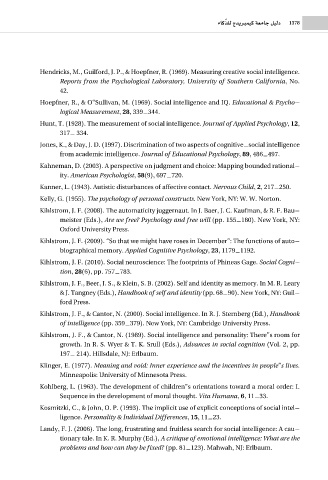Page 1379 - theCambridgehandbookofintelligence1
P. 1379
AÉcòs ∏d êójôѪ«c á©eÉL π«dO 1378
Hendricks, M., Guilford, J. P., & Hoepfner, R. (1969). Measuring creative social intelligence.
Reports from the Psychological Laboratory, University of Southern California, No.
42.
Hoepfner, R., & O Sullivan, M. (1969). Social intelligence and IQ. Educational & Psycho-
logical Measurement, 28, 339-344.
Hunt, T. (1928). The measurement of social intelligence. Journal of Applied Psychology, 12,
317- 334.
Jones, K., & Day, J. D. (1997). Discrimination of two aspects of cognitive-social intelligence
from academic intelligence. Journal of Educational Psychology, 89, 486-497.
Kahneman, D. (2003). A perspective on judgment and choice: Mapping bounded rational-
ity. American Psychologist, 58(9), 697-720.
Kanner, L. (1943). Autistic disturbances of affective contact. Nervous Child, 2, 217-250.
Kelly, G. (1955). The psychology of personal constructs. New York, NY: W. W. Norton.
Kihlstrom, J. F. (2008). The automaticity juggernaut. In J. Baer, J. C. Kaufman, & R. F. Bau-
meister (Eds.), Are we free? Psychology and free will (pp. 155-180). New York, NY:
Oxford University Press.
Kihlstrom, J. F. (2009). “So that we might have roses in December”: The functions of auto-
biographical memory. Applied Cognitive Psychology, 23, 1179-1192.
Kihlstrom, J. F. (2010). Social neuroscience: The footprints of Phineas Gage. Social Cogni-
tion, 28(6), pp. 757-783.
Kihlstrom, J. F., Beer, J. S., & Klein, S. B. (2002). Self and identity as memory. In M. R. Leary
& J. Tangney (Eds.), Handbook of self and identity (pp. 68-90). New York, NY: Guil-
ford Press.
Kihlstrom, J. F., & Cantor, N. (2000). Social intelligence. In R. J. Sternberg (Ed.), Handbook
of intelligence (pp. 359-379). New York, NY: Cambridge University Press.
Kihlstrom, J. F., & Cantor, N. (1989). Social intelligence and personality: There s room for
growth. In R. S. Wyer & T. K. Srull (Eds.), Advances in social cognition (Vol. 2, pp.
197- 214). Hillsdale, NJ: Erlbaum.
Klinger, E. (1977). Meaning and void: Inner experience and the incentives in people s lives.
Minneapolis: University of Minnesota Press.
Kohlberg, L. (1963). The development of children s orientations toward a moral order: I.
Sequence in the development of moral thought. Vita Humana, 6, 11-33.
Kosmitzki, C., & John, O. P. (1993). The implicit use of explicit conceptions of social intel-
ligence. Personality & Individual Differences, 15, 11-23.
Landy, F. J. (2006). The long, frustrating and fruitless search for social intelligence: A cau-
tionary tale. In K. R. Murphy (Ed.), A critique of emotional intelligence: What are the
problems and how can they be fixed? (pp. 81-123). Mahwah, NJ: Erlbaum.

